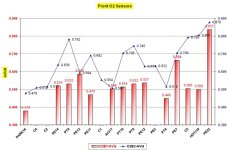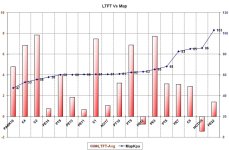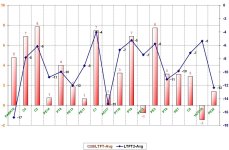teamzr1
Supporting vendor
If people like it or not, vehicles and how they function have been getting more complex in how they function and have a pupose
Question, what are Oxygen sensors and their purpose ?
Keeping the internal combustion engine as close to the stoichiometric ratio as possible will result in optimum catalytic converter efficiency and fuel economy. The stoichiometric ratio simply means that all the air (14.7 parts) and fuel (1 part) going into the cylinders are being converted to water and carbon dioxide exiting the exhaust. This is the perfect combustion reaction, but this desired stoichiometric operation can’t happen without fuel control.
Engine fuel control or closed loop operation is conducted by using the real time data from the oxygen or Air Fuel Ratio (AFR) sensors (and many other engine sensors) that are measuring and reporting the oxygen level that is in the engine’s exhaust gas stream. When the Powertrain Control Module (PCM) gets this exhaust oxygen level data, it will adjust the amount of fuel that the engine gets, always trying to keep as close to stoichiometric as it can.
The oxygen or AFR sensor isn’t really measuring the amount of oxygen in the exhaust gases.
Rather, it is measuring the difference in the amount of oxygen in the exhaust versus the amount of oxygen in the air. (We will cover this better in a bit.)
Today’s oxygen sensors or the more common AFR ratio sensors are very efficient at measuring the amount of oxygen that is in the exhaust system and providing that information to the PCM that will make the needed adjustments to the amount of fuel that it is supplying to the engine.
The technology has progressed to the point that the PCM can adjust the amount of fuel that each individual cylinder is getting (Individual Cylinder Fuel Control or ICFC). If one specific cylinder has been over or under fueled, the PCM will adjust the fueling, specifically compensating for that cylinder’s fueling needs.
The main difference between an AFR sensor (often called “the wideband sensor”) and the standard oxygen sensor (often called the “narrowband sensor”) is their operational sensing range. The AFR sensor can detect a much wider and leaner range of fuel mixtures. This larger sensing range enables better fuel control over a much wider engine operating condition.
Today’s AFR sensors are capable of reporting exhaust oxygen levels (a reflection of fuel mixture) under wide open throttle or very lean burning cruise operations, something that the earlier oxygen sensor was simply not capable of doing.
Keeping the fuel control as close to stoichiometric as possible allows the catalytic converter to function at maximum efficiency, improving emissions, but this stoichiometric operation also ensures the best fuel economy as well. This wider spectrum of operation is why the AFR is now the preferred exhaust sensing device.
But the standard oxygen sensor is still being used to check the oxygen storage capabilities of the catalytic converter, and in many cases these “catalytic converter monitor” oxygen sensors are being used to fine-tune the engine’s fuel mixture to maximize engine and catalytic converter efficiency.
The simplest oxygen sensor uses a porous ceramic sensing element with a platinum covered area for oxygen detection. The Titania sensor uses a porous ceramic sensing element made of titanium dioxide and platinum-coated detection areas.
The Zirconia sensor uses a Nernst cell for oxygen detection. The Nernst cell is made up of a porous zirconium oxide ceramic sensing element and platinum-coated detection areas.
The common wideband AFR sensor is going to use a combination of devices; a Nernst cell and a pump cell to detect and report oxygen levels in the exhaust.
The common part of these oxygens and AFR measuring devices is the fact that they are all using a process called diffusion. This diffusion takes place across the porous, precious metal coated ceramic sensing element and allows the comparison of the oxygen content of the outside air to the oxygen content of the exhaust gases.
The porous sensing element that allows the diffusion must be kept free of debris and contamination for it to accurately detect the difference in oxygen levels. If the surface of the sensing element becomes coated or contaminated with a foreign substance, it will become poisoned or suffocated and will no longer allow proper oxygen diffusion.
As the sensing element chokes, the sensor’s output will become slower, lazy, and less accurate and over time eventually will fail completely.
But a poisoned sensor isn’t the only frequent cause of death for an oxygen or AFR sensor. The internal heater can also fail. For proper oxygen and AFR operation, the sensing element must be kept hot.
The sensing element is heated by an internal electrical heater to a functional temperature of 600 F (316 C) to 665 F (350 C) for sensor operation.
Question, what are Oxygen sensors and their purpose ?
Keeping the internal combustion engine as close to the stoichiometric ratio as possible will result in optimum catalytic converter efficiency and fuel economy. The stoichiometric ratio simply means that all the air (14.7 parts) and fuel (1 part) going into the cylinders are being converted to water and carbon dioxide exiting the exhaust. This is the perfect combustion reaction, but this desired stoichiometric operation can’t happen without fuel control.
Engine fuel control or closed loop operation is conducted by using the real time data from the oxygen or Air Fuel Ratio (AFR) sensors (and many other engine sensors) that are measuring and reporting the oxygen level that is in the engine’s exhaust gas stream. When the Powertrain Control Module (PCM) gets this exhaust oxygen level data, it will adjust the amount of fuel that the engine gets, always trying to keep as close to stoichiometric as it can.
The oxygen or AFR sensor isn’t really measuring the amount of oxygen in the exhaust gases.
Rather, it is measuring the difference in the amount of oxygen in the exhaust versus the amount of oxygen in the air. (We will cover this better in a bit.)
Today’s oxygen sensors or the more common AFR ratio sensors are very efficient at measuring the amount of oxygen that is in the exhaust system and providing that information to the PCM that will make the needed adjustments to the amount of fuel that it is supplying to the engine.
The technology has progressed to the point that the PCM can adjust the amount of fuel that each individual cylinder is getting (Individual Cylinder Fuel Control or ICFC). If one specific cylinder has been over or under fueled, the PCM will adjust the fueling, specifically compensating for that cylinder’s fueling needs.
The main difference between an AFR sensor (often called “the wideband sensor”) and the standard oxygen sensor (often called the “narrowband sensor”) is their operational sensing range. The AFR sensor can detect a much wider and leaner range of fuel mixtures. This larger sensing range enables better fuel control over a much wider engine operating condition.
Today’s AFR sensors are capable of reporting exhaust oxygen levels (a reflection of fuel mixture) under wide open throttle or very lean burning cruise operations, something that the earlier oxygen sensor was simply not capable of doing.
Keeping the fuel control as close to stoichiometric as possible allows the catalytic converter to function at maximum efficiency, improving emissions, but this stoichiometric operation also ensures the best fuel economy as well. This wider spectrum of operation is why the AFR is now the preferred exhaust sensing device.
But the standard oxygen sensor is still being used to check the oxygen storage capabilities of the catalytic converter, and in many cases these “catalytic converter monitor” oxygen sensors are being used to fine-tune the engine’s fuel mixture to maximize engine and catalytic converter efficiency.
The simplest oxygen sensor uses a porous ceramic sensing element with a platinum covered area for oxygen detection. The Titania sensor uses a porous ceramic sensing element made of titanium dioxide and platinum-coated detection areas.
The Zirconia sensor uses a Nernst cell for oxygen detection. The Nernst cell is made up of a porous zirconium oxide ceramic sensing element and platinum-coated detection areas.
The common wideband AFR sensor is going to use a combination of devices; a Nernst cell and a pump cell to detect and report oxygen levels in the exhaust.
The common part of these oxygens and AFR measuring devices is the fact that they are all using a process called diffusion. This diffusion takes place across the porous, precious metal coated ceramic sensing element and allows the comparison of the oxygen content of the outside air to the oxygen content of the exhaust gases.
The porous sensing element that allows the diffusion must be kept free of debris and contamination for it to accurately detect the difference in oxygen levels. If the surface of the sensing element becomes coated or contaminated with a foreign substance, it will become poisoned or suffocated and will no longer allow proper oxygen diffusion.
As the sensing element chokes, the sensor’s output will become slower, lazy, and less accurate and over time eventually will fail completely.
But a poisoned sensor isn’t the only frequent cause of death for an oxygen or AFR sensor. The internal heater can also fail. For proper oxygen and AFR operation, the sensing element must be kept hot.
The sensing element is heated by an internal electrical heater to a functional temperature of 600 F (316 C) to 665 F (350 C) for sensor operation.




